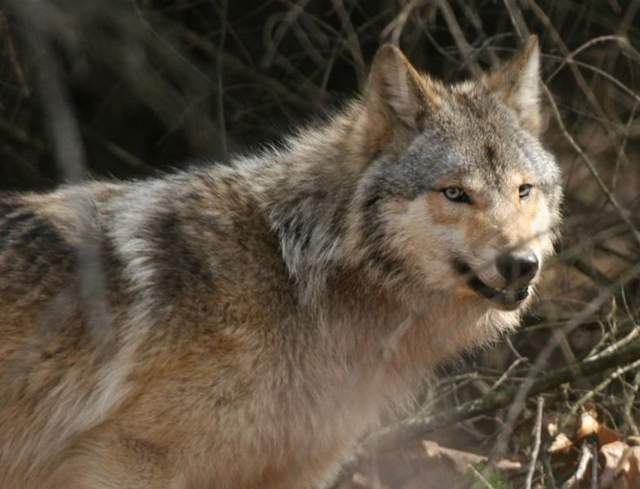Survey examines opinions about Wisconsin’s first managed wolf hunt

If one of the goals of Wisconsin’s wolf hunt was to increase tolerance for the species, the first season did not appear to accomplish this objective, say researchers from the Nelson Institute for Environmental Studies.
Photo: Jayne Belsky via Wisconsin DNR
Many Wisconsin residents supported the state’s decision to initiate the first managed wolf hunt in state history from October through December 2012, but support varied significantly between people who lived inside wolf range and those who did not, a new UW–Madison study indicates.
The researchers looked at results from two surveys. In 2013, they conducted a mail survey of 772 people living in and outside of areas designated as wolf range, which is predominately the state’s central forest and the northern part of the state. All the respondents who were residents of wolf range had also been asked many of the same questions in a 2009 survey, which allowed researchers to see whether opinions of wolf country residents had changed.

Jamie Hogberg
While the state’s wildlife managers had hoped that the 2012 hunt would increase tolerance for wolves, the study suggests that this is not the case — at least, not yet. Fifty-one percent of the wolf country residents surveyed in 2009 had indicated that they would be more tolerant of wolves if people could hunt them. But in 2013, these respondents showed a net shift towards disagreement that their tolerance had risen after the 2012 wolf-hunt.
When examining the entire sample of respondents both inside and outside of wolf range, 37 percent of respondents said they were more tolerant of wolves since people could hunt them.
Very few of the respondents in the 2013 survey felt that their opinions about wolves in Wisconsin had changed since the 2012 hunt. Eighty-one percent said that their tolerance for wolves had not changed, while 14 percent said they were more tolerant and 5 percent said they were less tolerant. There were no significant differences in self-reported changes in tolerance between residents of wolf-range and non-wolf range.
“If one of the goals of the wolf hunt was to increase tolerance for the species, the first season did not appear to accomplish this objective,” says Jamie Hogberg, a graduate student in the Nelson Institute for Environmental Studies who was on the study team.
“If one of the goals of the wolf hunt was to increase tolerance for the species, the first season did not appear to accomplish this objective.”
Jamie Hogberg
The researchers also examined support for various restrictions on wolf hunting. Of those living outside of wolf range, 68 percent opposed hunting pups, 61 percent opposed hunting with hounds, 57 percent opposed hunting at night and 61 percent opposed hunting during the breeding and pregnancy seasons.
Among those living in wolf country, 44 percent opposed hunting pups, 36 percent opposed hunting with dogs, 45 percent opposed hunting at night and 37 percent were against hunting during breeding and pregnancy seasons.
Although these results suggest wolf country residents are more lenient about wolf hunting rules, in fact wolf country residents appear to have shifted opinions about these restrictions between the 2009 and 2012 surveys. Opposition to hunting wolf pups and to hunting with dogs both rose 7 percent. Support for restrictions on trapping, baiting, out-of-state hunters, predator calling, and hunting only wolves that caused property damage rose by 3-6 percent. However, since 2009 there was also a similar increase in the number of respondents who said they wanted to be able to hunt wolves without restrictions.
“None of the hunting rules received less support since 2009 and the greatest increases in support surfaced for those restrictions that had received media attention in the last year,” says Adrian Treves, associate professor with the Nelson Institute. “Increased publicity and awareness about the state’s first wolf hunt may have led people to engage on the topic and think about wolf management and the design of the hunt.”

Adrian Treves
As expected, far more hunters than non-hunters (79 percent vs. 33 percent) approved of the legislative decision to open the 2012-13 wolf hunting and trapping season.
A significant majority of those living in wolf range supported the hunt: 76 percent of respondents approved, while 13 percent disapproved and 11 percent were neutral or did not know. Support for the hunting season among those living outside of wolf range was mixed: 41 percent were in favor, 34 percent were opposed and 25 percent were neutral or did not know.
“While this is not surprising, it may point to the need for educating the public about the state’s wolf management plan along with more dialogue about the issue and making sure all perspectives are heard and considered, including both hunters and the non-hunting public,” says Bret Shaw, associate professor in the Department of Life Sciences Communication and environmental communication specialist for UW-Extension.
The research team consisted of Treves, Hogberg, Shaw and Professor Lisa Naughton from the Department of Geography. Financial support came from the U.S. Fish and Wildlife Service and UW–Madison.




